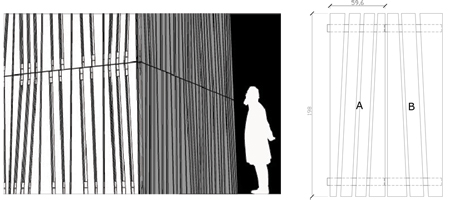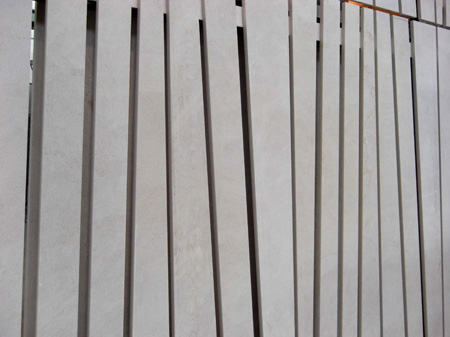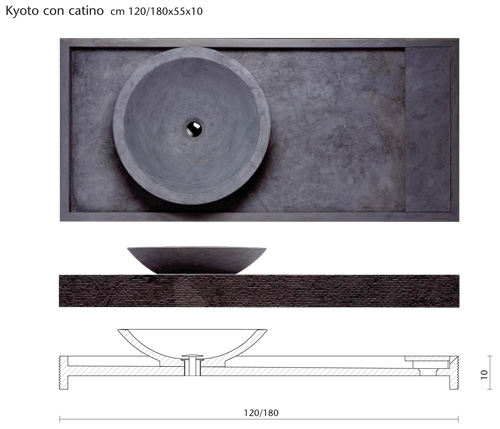23 Settembre 2008
English
A STONE “PALISSADE”
Pibamarmi, Michele De Lucchi and Philippe Nigro for Marmomacc 2008
[videointervista]11_int_nigro.swf[/videointervista]
One year after the beginning of “Marmomacc incontra il design” (“Marmomacc meets Design”), the collaboration between stone industry companies and the world of design is taking a new direction.
The international exhibition Marmomacc 2008, that is going to open its doors to the public between 2nd and 5th October in Verona, wants to reappoint as a major platform of discussion and collaboration between the contemporary productive reality and new protagonists in the creativity world, a cooperation that aims to develop researches applied to stone employment in design creations, moving forward previously unexplored cultural and industrial landscapes and investigating new potentials of stone materials.
The previous edition focused on the lightness of marble and proved to be rich in interesting improvements both in the creative and the productive processes: if design is structured as a combination of concepts made of different grades and cultural themes, production, employing always more and more sophisticated technologies, can by now answer to multi-related demands thanks to highly refined products.
This year Verona fair is going to renew this challenge, giving to the collaborations started during the 2007 event the chance to renovate and develop new projects that will compete in the second edition of the “Best Communicator Award”.
Last year winners, Pibamarmi and Michele De Lucchi, are competing this year as well, now joined by French designer Philippe Nigro: they have decided to participate in this competition conceiving, projecting and creating a new exhibition stand.
This year’s edition focuses on the topic of “Pelle, Skin, Texture”, involving contemporary architecture, object design and technology.
Traditionally linked to architecture or industrial design history, the superficial structure of the materials now becomes a more topical issue also thanks to the support of new technological and morphological improvements in the world of building materials.
Always more refined and varied manufacturing techniques are being developed together with compositional and constructive experimentations that aim to enlighten new hidden potentials in the different materials. Various architectural projects suggest buildings that become light covering surfaces worked up in order to hide retaining structures, where plates characterize the architectural language of the project, often contrasting with the massive and stative nature of the architecture but also giving the chance to stress the attention on tectonical aspects; in this way, design objects and furniture elements have the opportunity, in a little scale, to be in even more numerous ways characterized by superficial processing.
If technological advancements have made possible the invention of new and various artificial materials, this approach can renovate the possible use and employment of traditional ones. Together with classical elements as metal and bricks, wood and stone can be used in a wider range of applications, sometimes going beyond traditional and well-established processes.
Marble is one of the finest stone materials and can now achieve a new modernity: from smooth surfaces to coarse surfaces, from massive panels to thin plates with the aspect of translucent leaves, to marble blocks manufactured with diversified conformations, frames and textures.
2008 “Marmomacc meets Design” is going to offer the public the chance to find out new industrial suggestions linked to the superficial nature of this rich and sophisticated material.
As it did in the previous years, Pibamarmi differs from the classic use of marble presenting an innovative project based on the definition of covering surface containing the accessories to be exhibited.
Michele De Lucchi, in partnership with his assistant Philippe Nigro and Pibamarmi architect Damiano Steccanella, is moving from the idea of traditional stand to the creation of a marble palissade. Visitors can perceive its content from the outside and then can enter the structure, walk into it, take a sit, look with particular attention at the different bathroom equipments that Pibamarmi firm have been producing with refined quality and sensibility for forty years by now.

It could be very interesting to trace back the path that has led to this project, in order to fully appreciate the philosophy that guided its conception.
The proposed topic has seemed very coherent with recent works by De Lucchi: natural materials employment and crescent sensibility towards handmade products, different materials processes and new possible superficial solutions.
The perfection reached by stone block refinition instruments, most of them with numerical control, opened new ways to infinite interpretations of surface finish that move attention on internal characteristics, rather than on the signs left by the instruments during the manufacturing. There’s a new tendency in revealing intimate naturality of the stones conserving its rough original traits.
Philippe Nigro joined De Lucchi’s creativity, after being his collaborator since 1999 and co-designer of Pibamarmi stand at 2007 Marmomacc. Nigro has been working in the last years on real or illusory pliability of materials and on the plastic game of volumes, shapes and colours.
Pibamarmi itself offers to the project its high operative professionalism and shows in the exhibition its new collection, “Stone likes water”: all the products, designed by Japanese architect Hikaru Mori, can be included in that minimal naturalistic standard typical of Japanese culture, called Wabi-Sabi.
De Lucchi and Nigro’s approach to the project and the research for essential atmospheres typical of the production line of the firm, can easily conciliate in a common path which Pibamarmi, through the management work by Damiano Steccanella and all the technical experience cumulated in the last years, can give concreteness to.

De Lucchi and Nigro have based their project on three concepts: stone employment, search for a bidirectional visibility of the pavilion (outside/inside and inside/outside), conservation of superficial signs left on the marble by cutting, fissuring and manufacturing instruments.
The transfiguration of the plate in a fragment of wooden palissade is suggested by projecting a 200x60cm module that architect and manager Damiano Steccanella puts in a binary version on metal frames, that he conceived himself. The so-obtained surfaces give life to a rhythmic map, formed by the overlap of squared and rectangular shapes.
The stand is like a fence accessible through different entries and can be visited through various directions, allowing the visitor to take a look walking around rather than statically observe the structure having a sit. Design objects, perfectly inserted in the pavilion context, modulate the visit and the different directions: Wabi pools, Kyoto basins and Osaka shower plates suggest oriental atmospheres with essential naturality, underlined by wrapping lighting coming from lamps on the upper beams.

Everything becomes exhibition scene: the stand and the inside manufactures. Container and contained form a unique stone environment that can be identified with the modern conception of a bathroom: not necessarily a closed and separated room, but a place to be lived and dedicated to wellness and body care, pulled apart only by optical filters.
Using stone materials and underlining their lightness and malleability, Pibamarmi puts together minimal, stereometrically pure and perfect forms and diversified solutions that play on the sensory effect of their employment and on skin contact with surfaces able to recreate vivid sensations in the artificial environment of the house.
Masterly, the new project transforms a place originally conceived as a simple exhibition space, with evident communicative potentials, in a architectural and extremely poetic manufacture. And it’s through this manufacture that Pibamarmi shows to its public the experimental research of its brand and the productive and executive quality being the core of its activity.
Texts by Sara Benzi
Scarica l’invito
(Go to Philippe Nigro)
(Go to Pibamarmi)
